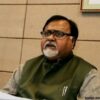Uttar Pradesh: No great shakes
-Nishant Saxena (Lucknow)
On july 24, residents of Lucknow (pop.3.8 million), the administrative capital of the Hindi heartland, BJP-ruled state of Uttar Pradesh, woke up to bold face newspaper headlines and screaming television news anchors proclaiming that seven out of 18 students who attained the top score of 99.75 percent in the recently-completed class XII ISC exam of the Delhi-based Council for Indian School Certificate Examinations (CISCE) board, are from schools in the state.
Informed academics in Lucknow University, the state’s premier varsity (estb.1920) which was awarded the highest A++ grading (cumulative grade point average of 3.55 out of a maximum 4) of the Bengaluru-based National Assessment and Accreditation Council (NAAC) on July 26 to become the first university in UP to be awarded this status, are less impressed.
According to them, given the huge population of UP (215 million) — “if Uttar Pradesh was a nation instead of a state, it would be fifth most populous country in the world” — seven students topping a national exam is nothing to write home about. Secondly, of UP’s total number of 243,000 primary-secondary schools, a mere 436 are affiliated with the upscale CISCE examination board which prescribes stringent infrastructure, teacher-pupil ratio and other qualitative norms as preconditions of affiliation. All told, UP’s CISCE-affiliated schools — headed by the Lucknow-based City Montessori School with 17 campuses in the city and certified by Guinness Book of World Records as the world’s largest single-city primary-secondary (aggregate enrolment: 58,000) and routinely ranked UP’s #1 co-ed day school — have a modest 500,000 children on their muster rolls.
Nor are other monitors of the neglected education system of the country’s most populous state impressed. Niti Aayog, the Union government’s think tank which replaced the Nehruvian Soviet-inspired Planning Commission in 2015, ranks Uttar Pradesh #19 among India’s 28 states on its SDG Index of Quality Education with a score of 21 cf. the national average of 29. Worse, the Delhi-based Observer Research Foundation ranks it #19 among major states in its PIE (performance infrastructure & equity) Index 2020-21, just ahead of last-ranked Bihar.
The low-ranking routinely awarded to UP in all national surveys is the outcome of the state’s dismal data on several parameters of public education management. For instance, in the state’s 169,000 government and aided schools, the teacher-pupil ratio is 1:39 as against the 1:25 recommended by the RTE Act, 2009; UP hosts the largest number of single teacher schools (22,223) and an estimated 25 percent of the state’s 670,000 government school teachers are absent from work every day.
Although Uttar Pradesh has a long history of education neglect — especially of foundational primary education under Congress governments which ruled the state for over half a century after independence — educationists in Lucknow believe that the situation has worsened since the incumbent BJP government led by saffron clad monk Yogi Adityanath was swept to power in Lucknow in the legislative election of 2017. The consensus is that BJP governments at the Centre and states are more interested in rewriting history from the hindutva perspective than in normative education.
“Although the new academic year began in April, our school hasn’t received new textbooks for the academic year 2022-23, despite the school having been shut down for 80 weeks because of the Covid pandemic. This apart, the state government believes that teachers are multipurpose employees who can be tasked with all sorts of jobs. We are routinely assigned local government administrative jobs in the village, leaving us little time to teach,” says Vijay Sonker, a teacher at a government high school in Sitapur.
However Prof. Tripta Trivedi, who heads the education faculty at Lucknow University, believes that as indicated by students from UP topping the ISC exam, there is a “positive shift,” in education statewide. “This is a period of transition for education in Uttar Pradesh. Within government and the academy there is greater awareness of the importance of vocational education and training for employment, learning of English, soft skills and rising awareness of the importance of integrating technology into the education system at all levels. This is bound to raise teaching-learning standards in the near future,” says Trivedi.
Such optimism is good news. Because unless there is a sharp improvement of learning outcomes — the prerequisite of industry, agriculture and government productivity — in India’s most populous state, the country’s transformation into a global superpower will remain a pipedream.
Also Read: CBSE Class 12 results 2022: Two Uttar Pradesh girls top country
















Add comment